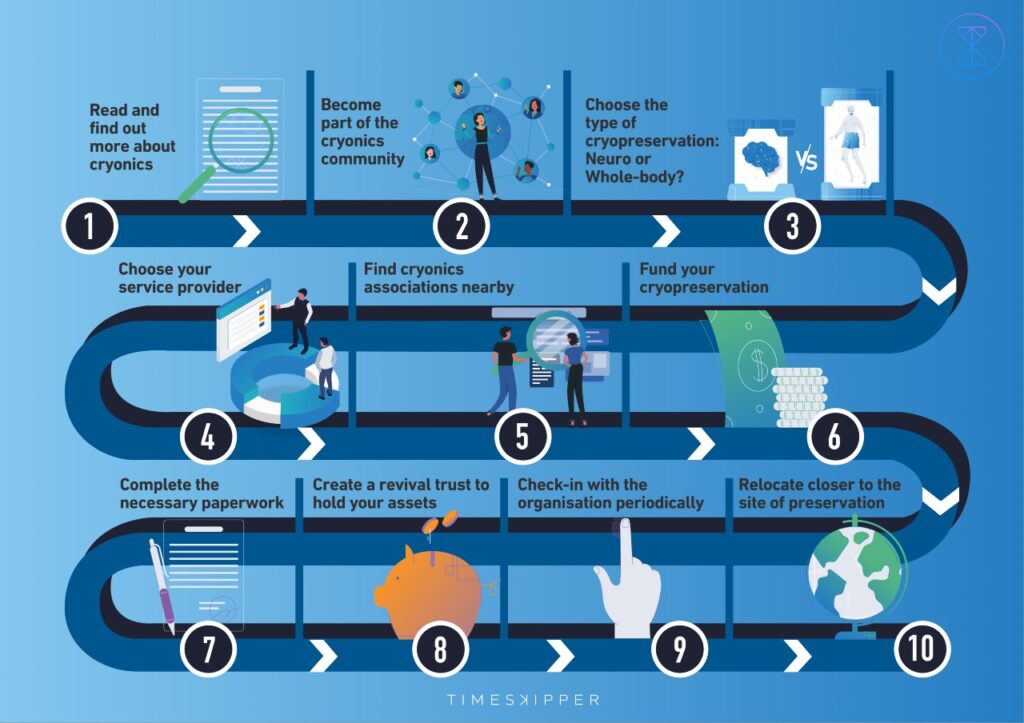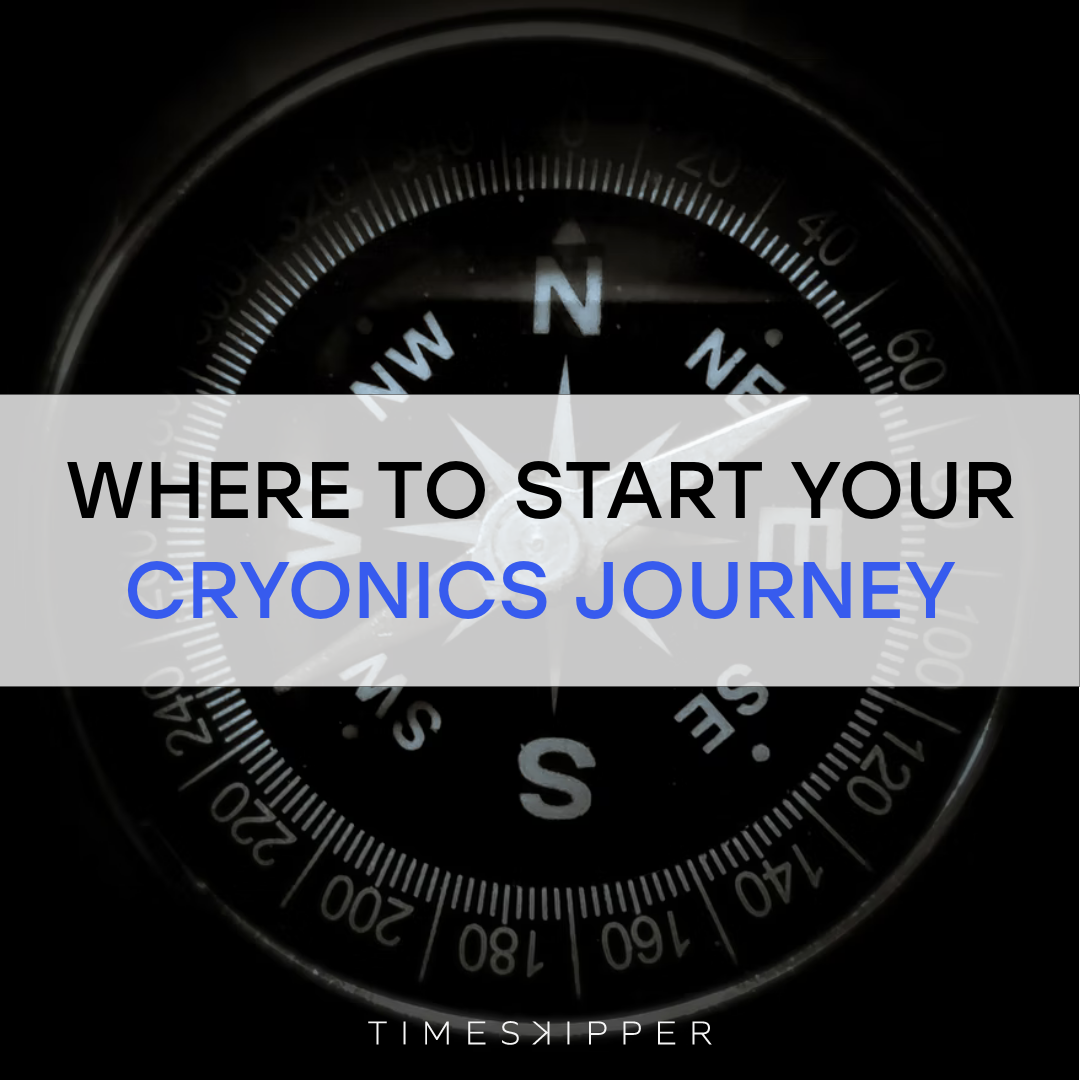One might come to the decision to sign-up for cryopreservation. But, what next? What are the steps to be followed, and what are the important things to be considered? Read on to find out everything you need to know from beginning to end about signing-up for cryopreservation.
1. Read and find out more about cryonics
The natural and foremost thing to do before getting neck-deep into anything, especially liquid nitrogen, would be to read and get in-the-know about it; and the same applies to cryopreservation as well. Cryopreservation is the process of suspending a legally deanimated person in extremely low temperatures, under monitored conditions, with the purpose of reanimating them, when advancements in science and technology allow for it. Although it is still entering the stage of popularity, cryonics has been around for the past few decades, and as such, there is a lot to uncover about it. With time and experience, cryonics organisations have grown, not only in number, but also in the quality and nature of services provided by them. A person considering to be cryopreserved needs to know the science, the finance, and other useful information about it. One of the easiest ways to achieve this is by reading up about the intersections between cryonics and these different sectors. The Timeskipper blog is a good place to start your explorations into the world of cryonics.
2. Become part of the cryonics community
The cryonics community is a homogenous one, consisting of all cryonics enthusiasts sharing common interests and concerns. Their approach to questions of life, death and reanimation also take the same path, making them a unique community, as distinct from non-cryonicists. The community also propels people who are cryocurious or cryocrastinators to make a decision about their cryopreservation, by supporting them and providing them with the necessary information. One can have discussions and ask anyone in the community who has experienced similar dilemmas, or situations, questions about the above points. One can also take part in community activities, such as attending conferences, training programs, and interactions on platforms like The Cryosphere or Timeskipper, essentially networking with like-minded individuals. Having a community which shares similar interests acts as a massive bonus and is likely to enrich one’s cryonics experience.
3. Choose the type of cryopreservation: Neuro or Whole-body?
Human cryopreservation is carried out in one of the two ways: neuropreservation or whole-body cryopreservation. One can choose between the two based on their preferences and other considerations applicable to their situation. Through neuropreservation, only the patient’s brain is cryopreserved upon their legal death. The ultimate goal here is to be able to reverse the fatal injuries sustained by the brain when the technology becomes available. It is therefore focused on doing the best possible job to preserve the human brain. On the other hand, whole-body cryopreservation preserves the entire human body upon legal death in liquid nitrogen, after carrying out perfusion and blood-washout procedures.
Both of these have their own strengths and challenges in terms of biological, financial, and other components. Preserving a brain consumes less space than preserving a whole body, but on the other hand, if and when revival becomes successful, the cryopreserved brain would need a body to function through. While the feasibility and dynamics of this can be somewhat of a conundrum, whole-body preservation has the edge, as a tangible body, if rightly preserved, will also preserve the identity of the patient for revival. With regards to cost, neuropreservation is the clear winner as there is a considerable difference between the two. However, there are organisations who specifically focus only on providing the whole-body cryopreservation option, which they feel is more comprehensive (e.g. Cryonics Institute, Tomorrow Biostasis). Ultimately however, each individual must make their own decision based on their circumstances and preference.
4. Choose your service provider
After one decides on the type of cryopreservation, the next, or sometimes even concurrent step, would be to register with the right cryonics organisation or facility. Cryonics organisations that provide long-term cryopreservation and storage are: Alcor and the Cryonics Institute in the United States, KrioRus in Russia, Tomorrow Biostasis in Europe, Yinfeng in Japan, and Southern Cryonics in Australia. An important consideration here would be the cost of cryopreservation. Read here for further information on the reasons behind these costs, and for a comprehensive price comparison list.
You can also read more about how these services compare here. Apart from these, the Yinfeng Life Science Research Institute reportedly estimates its charges at 2 Million Yuan (~$316,055) which is said to provide for 20-30 years of cryopreservation.
5. Find cryonics associations near you
Despite the growth in the number and spread of cryonics facilities, they do not comprehensively cover the entire globe. So, if one is looking to be cryopreserved at any of the abovementioned places, and if they are not locals or nationals of the country where they are situated, they will need some assistance, which can be provided by cryonics associations around the world. These organisations are mostly formed as non-profit entities or charities, and generally made up of volunteers who are cryonics enthusiasts. They assist foreigners who have signed-up for cryopreservation in availing standby, check-in, transportation and other related services. Since not all cryonics facilities provide for these services internationally, one might want to accept the help of these voluntary service providers. Some of them also carry out research activities, and provide valuable resources to those who conduct cryopreservation practically.
Moreover, the person considering signing up for cryonics can also become a part of such organisations and volunteer alongside them, thereby giving them a comprehensive cryonics experience. These associations also conduct promotional activities such as cryonics first-response training in their regions, which helps spread the word and improve some of the volunteers’ skills.
6. Fund your cryopreservation
After looking at the cost, the next step is all about ways to fund the cryopreservation. As we have seen, the cost ranges anywhere from $18,000 to $200,000. Additionally, the funding should be such that the minimum cost of cryopreservation is covered, to provide for a hassle-free cryopreservation; the funds should be readily available to the organisations, upon the legal death of the member, and the same must be uncontested by the legal heirs of the member, claiming the same as a part of their inheritance. One might also have to set aside additional expenses for standby, transport and other services. So, how are these done?
While prepayment might be the first option that comes to mind, it is also quite burdensome on an individual to save up that much at one time. Therefore, a popular option that has come to fore is life insurance. This works by the individual signing up for cryopreservation, taking out a life insurance policy, and designating the cryonics organisation as the beneficiary of the same. As insurance premiums are generally paid over a period of time, the weight of the payment is not as heavy. There are quite a few types of insurance to choose from, with some of them even tailored specifically for cryonics. Unusual Risks, Tomorrow Biostasis, Zurich Life Insurance all cater to cryonics funding through life insurance. There are a few other ways to fund cryopreservation: through a trust which provides secure funding; through annuity, or partial funding from real estate, and with other assets that the member may hold. The acceptance of these alternative methods of funding depends on the service provider that one signs up with.
7. Complete the necessary paperwork
After finalising the place and type of preservation, the next step is to kick-off the signing up process by putting pen to paper. Entering into a contract with the service provider is necessary so that it gives rise to reciprocal duties on both ends: the individual agrees to pay the required fees, while the service provider is duty bound to ensure proper cryopreservation and storage. The first document in line is the membership application form which one is required to submit to their desired cryonics organisation. These are usually made available on their website and require certain boilerplate details regarding the prospective member. Upon its acceptance, the cryopreservation agreement comes into the picture. In this agreement between the service provider and the member, certain terms are clearly set out so that nothing gets lost in the details, which could lead to confusion at a later point. They also acknowledge each other’s duties through this agreement, and it also provides for cancellation of cryopreservation on the member’s behalf, or termination by the service provider, if certain conditions are met.
In addition to this, depending on the service provider, one might also have to execute other documents such as the Last Will and Testament for Human Remains and Authorization of Anatomical Donation; Consent for Cryopreservation; Disclaimer document; Uniform Donor Form; Consent Release form, etc. In case of availing standby arrangements that are independent of the service provider’s activities, the necessary standby agreements need to be concluded. In order to ensure that the relatives of a cryonics member are aware of their intention to be cryopreserved, and that they will not challenge the same, Alcor and the Cryonics Institute make use of the Relative’s Affidavit and Next of Kin Agreement respectively. The funding documents, particularly in relation to life insurance, need to be deposited with the service provider. For organisations that provide cryopreservation for pets, agreements such as the Pet Cryopreservation Agreement might be necessary to bring the same into effect.
8. Create a revival trust to hold your assets
An individual signing-up to be cryopreserved obviously does it with the aim of potentially being reanimated in the future. In such a case, they would also need to carry their assets with them, so that they are not revived into a state of having nothing. In order to enable this, there are various cryonics-related trusts, which are created to hold the assets of an individual who has been cryopreserved during the period of their cryopreservation. These trusts need to overcome certain hurdles like the rule against perpetuities, to ensure that the assets can be preserved in trust for as long as possible and as long as necessary.
This is accomplished through dynasty trusts, and a variant of this is the Hoffman Prototype Cryonics Trust. The American Cryonics Society on the other hand uses the ACS Risk Management Approach to the Problem of Asset Preservation which in effect creates a dedicated fund in the name of each of its members through a trust. The dedicated fund will, in the first instance, act as a backup in case of any unforeseen contingencies during biostasis. The remaining funds will then be returned to the member for their personal needs upon reanimation. This form of asset preservation can also be made use of by non-members. Alcor has two trusts which provide for asset preservation. The Multi-Investment Future Income Trust, where assets valuing less than $500,000 are held, and the Alcor Model Revocable Asset Preservation Trust, which is a model trust document for preserving assets greater than $500,000 in value.
Therefore a person signing-up for cryopreservation can lock their assets up in a trust based on one of these model or prototype documents.
9. Check-in with the organisation periodically
As mentioned earlier, the window for conducting preliminary cryopreservation procedures immediately after deanimation is very narrow. Also, it is difficult to always predict when an individual might deanimate. Therefore, it becomes necessary to keep the cryonics organisation, with which one has signed up, periodically informed about one’s health condition, and also about any developments. Hospitalisation for terminal illness must compulsorily be notified to the service providers so that they can make standby and transport arrangements. Moreover, various cryonics service providers across the world offer check-in services and are on their toes to act in the event of an emergency. Alcor and the Cryonics Institute have their own “check-in” apps which come with an alarm and alert system. This is used to periodically check-in with the user, and if they fail to respond, the app will send an alert to their assigned contacts or to a standby team along with the location. Tomorrow Biostasis is coming up with a “Biostasis app” which is equipped with emergency triggers, automatic triggers, etc. Once released, it will be made available to use by the entire cryonics community. Therefore, it would be good if the person who has signed up for cryopreservation made use of these services and kept the cryonics organisation in the loop.
10. Relocate closer to the site of preservation
In order to increase the efficiency of cryopreservation, and reduce ischemia, it would be ideal if the person signed up for cryopreservation lived as close as possible to the cryopreservation centre, at least during their terminal illness. Alcor, for instance, strongly encourages its members who are terminally ill to relocate to hospice facilities in Scottsdale, Arizona, where the facility is. It further incentivises such a move by offering its members up to $10,000 towards relocation assistance. If one chooses not to relocate, then they should ensure to make proper transport arrangements, with a cryonics service provider. Progress is being made in this area by the Biostasis Science Foundation who are building a vehicle tailored to the specific requirements of cryonics operations in partnership with the National Ambulance Service. For overseas cryonics patients, they will need to make arrangements for a private flight to carry them with all the equipment to the site of preservation. As this is a relatively costly and complicated process, relocation is advisable, and in the best interests and circumstances of an individual.
















